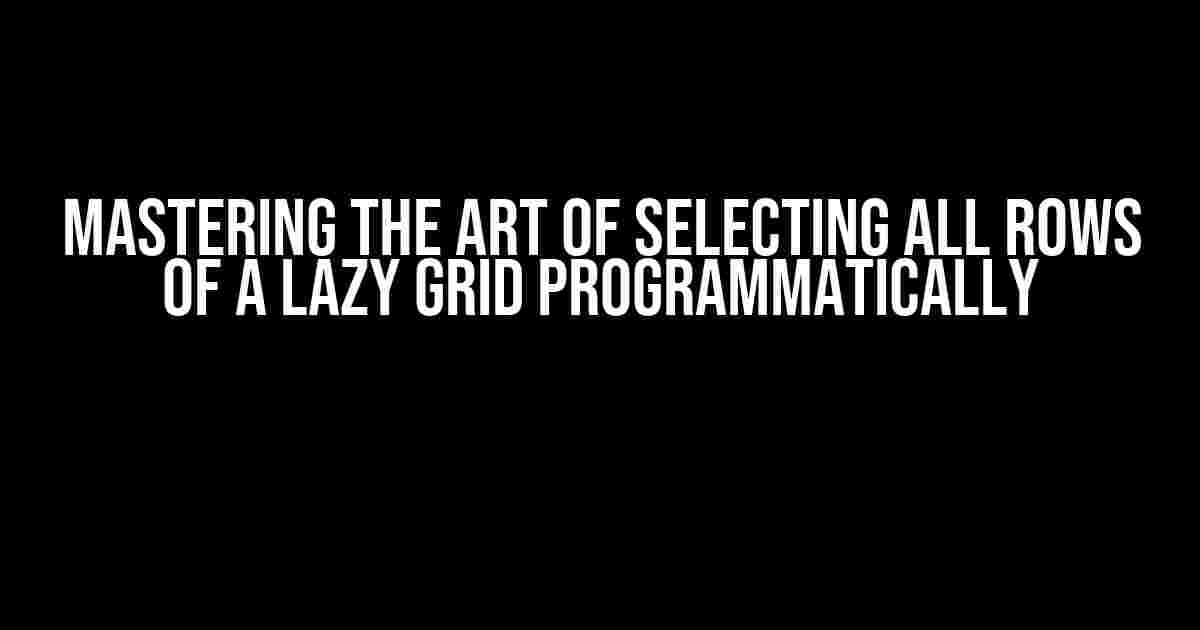Are you tired of manually selecting each row of your lazy grid, one by one, only to find that you’ve missed a few? Do you struggle with writing complex code to achieve this seemingly simple task? Fear not, dear developer, for we have got you covered! In this comprehensive guide, we will take you by the hand and walk you through the process of selecting all rows of a lazy grid programmatically.
What is a Lazy Grid?
Before we dive into the nitty-gritty of selecting all rows, let’s first understand what a lazy grid is. A lazy grid, also known as a virtual grid or on-demand grid, is a data grid that loads data only when it’s needed. This approach is particularly useful when dealing with large datasets, as it reduces the initial load time and improves overall performance.
Why Select All Rows Programmatically?
There are several scenarios where selecting all rows of a lazy grid programmatically is necessary:
- Data Export: You need to export the entire dataset to a CSV or Excel file.
- Data Processing: You want to perform batch operations on the entire dataset, such as data validation or formatting.
- You need to integrate the lazy grid with other UI components, such as charts or graphs, that require access to the entire dataset.
Approach 1: Using the Grid’s API
Most lazy grid libraries provide an API that allows you to interact with the grid programmatically. Let’s take a look at a few examples:
Example 1: Kendo UI Grid
var grid = $("#grid").data("kendoGrid");
grid.select("tr");In this example, we’re using the Kendo UI Grid’s API to select all rows of the grid.
Example 2: jQuery DataTables
var table = $("#table").DataTable();
table.rows().select();In this example, we’re using jQuery DataTables’ API to select all rows of the table.
Approach 2: Using JavaScript and DOM Manipulation
If the grid’s API doesn’t provide a way to select all rows programmatically, you can always fall back on good ol’ JavaScript and DOM manipulation.
Example 1: Selecting All Rows Using a Loop
var rows = document.querySelectorAll("#grid tr");
for (var i = 0; i < rows.length; i++) {
rows[i].classList.add("selected");
}In this example, we’re using the `querySelectorAll` method to get an array of all table rows, and then looping through each row to add a “selected” class.
Example 2: Selecting All Rows Using a Single Statement
document.querySelectorAll("#grid tr").forEach(function(row) {
row.classList.add("selected");
});In this example, we’re using the `forEach` method to iterate over the array of table rows and add a “selected” class to each row.
Approach 3: Using a Library or Framework
If you’re using a JavaScript library or framework, such as React or Angular, you may have access to additional tools and APIs that can help you select all rows of a lazy grid programmatically.
Example 1: React and React Table
import React, { useState, useEffect } from "react";
import { useTable } from "react-table";
const MyGrid = () => {
const [selectAll, setSelectAll] = useState(false);
const { getTableProps, getRowProps } = useTable();
useEffect(() => {
if (selectAll) {
getRowProps().forEach((rowProps) => {
rowProps.isSelected = true;
});
}
}, [selectAll]);
return (
<table {...getTableProps()}>
<thead>
<tr>
<th></th>
</tr>
</thead>
<tbody>
{getRowProps().map((rowProps) => (
<tr {...rowProps}>
<td></td>
</tr>
))}
</tbody>
</table>
);
};In this example, we’re using the React Table library to create a grid, and then using the `useState` and `useEffect` hooks to select all rows when the `selectAll` state is set to `true`.
Common Challenges and Solutions
When selecting all rows of a lazy grid programmatically, you may encounter some common challenges. Let’s take a look at a few solutions:
Challenge 1: Performance Issues
Selecting all rows of a lazy grid can be a computationally expensive operation, especially when dealing with large datasets. To mitigate this, you can use techniques such as pagination, caching, or optimizing your grid’s rendering.
Challenge 2: Grid Redrawing
When selecting all rows programmatically, the grid may redraw itself, causing the selection to be lost. To solve this, you can use the grid’s API to disable redrawing or use a library that provides a way to preserve the selection.
Challenge 3: Browser Limitations
Some browsers may have limitations on the number of rows that can be selected programmatically. To overcome this, you can use techniques such as chunking or batch processing.
Conclusion
Selecting all rows of a lazy grid programmatically is a challenging task, but with the right approach and tools, it can be achieved with ease. By using the grid’s API, JavaScript and DOM manipulation, or a library or framework, you can select all rows of a lazy grid and perform batch operations, data validation, or data export. Remember to consider performance issues, grid redrawing, and browser limitations when implementing this functionality.
| Grid Library | API Method | Example |
|---|---|---|
| Kendo UI Grid | select() | grid.select("tr"); |
| jQuery DataTables | rows().select() | table.rows().select(); |
| React Table | useTable() | import { useTable } from "react-table"; |
By following this comprehensive guide, you’ll be well on your way to mastering the art of selecting all rows of a lazy grid programmatically. Happy coding!
Frequently Asked Question
Are you tired of manually selecting all rows of a lazy grid? Look no further! Here are the answers to your burning questions on how to do it programmatically.
What is the easiest way to select all rows of a lazy grid?
You can use the `SelectAll()` method of the grid’s selection model. This method will select all rows in the grid, including those that are not currently visible due to lazy loading.
How do I access the selection model of a lazy grid?
You can access the selection model by using the `getSelectionModel()` method of the grid. This method returns an object that implements the `SelectionModel` interface, which provides methods for selecting and deselecting rows.
What if I want to select all rows in a specific range?
You can use the `SelectRange()` method of the selection model, which takes two parameters: the start row index and the end row index. This method will select all rows in the specified range.
How do I know when all rows have been selected?
You can listen to the `SelectionChanged` event of the selection model, which is fired whenever the selection changes. When the event is fired, you can check the `GetSelectedRowCount()` method to see if all rows have been selected.
Can I select all rows of a lazy grid in a single operation?
Yes, you can use the `SelectAllRows()` method of the grid, which will select all rows in a single operation. This method is more efficient than selecting rows one by one, especially for large datasets.


